
Pediatrics(2)
.pdf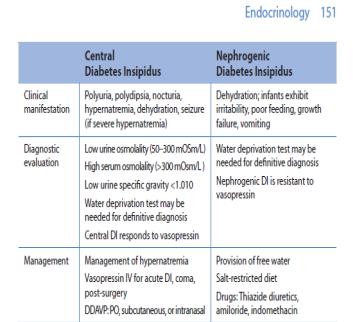
-
SEXUAL DEVELOPMENT Normal Sexual Development
•In girls, thelarche (breast development) starts at 8–13 yr; varies by ethnic group) pubarche
(pubic hair development) menarche (2.3 yr ± 1 SD from thelarche)
•In boys, gonadarche (testicular enlargement) starts at 9–14 yr pubarche (secondary sexual characteristics, eg, voice change, growth spurt, pubic hair) occurring approximately halfway through the process
Delayed Puberty
•Girls: No thelarche by age 13 yr, or no pubarche by age 14 yr, or no
menarche by age
16 yr or >5 yr between thelarche and menarche.
•Boys: No gonadarche by age 14 yr, or no pubarche by age 15 yr, or >5 yr required tocomplete testicular enlargement
•Pubertal arrest = No progress in puberty over two years.
Precocious Puberty
• Pubertal development in girls before age 8 yr and in boys before age 9 yr (there is ethnic variation for thelarche: caucasian girls as early as age 7 yr and African American girls as early as age 6 yr but without other signs of development).
- TANNER STAGES IN GIRLS AND BOYS
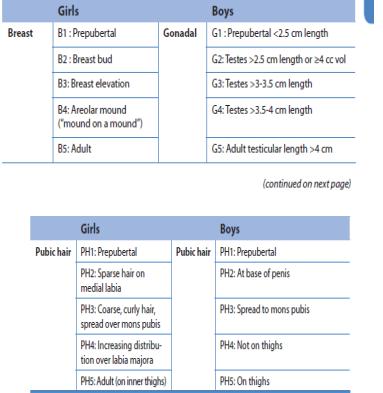
-
-
-
Dr: Essam Abdullah 01123232188
-
-6. Musculoskeletal Conditions
-6.1. Septic Arthritis
-Definition: Septic arthritis is defined as an acute articular suppurative
-infection caused by pyogenic micro-organisms
-Causes
-Neonates S.aureus, Group B. Streptococci, E. coli, fungi
-Infants/children S.aureus, H. influenzae, Group A Streptococci,S. pneumonia
-Children - sexually active N. gonorrhoea
-Chronic septic arthritis Brucella, tuberculosis, atypical mycobacteria, fungi and other uncommon organisms
-Risk factors
-- Trauma
-- Rheumatoid arthritis or osteoarthritis
-- Sickle cell disease
-- Skin infections
-- Sexual activity
-- Immune deficiency (HIV, etc.)
-signs and Symptoms
-- In neonates and infants
-• Signs and symptoms may be subtle (not well remarked)
-• diminished movement of the extremity
-• digestive disturbance
-• Poor progression of weight
-• Fever
-• Septicemia
-• Swollen, warm and painful joints
-- Older infants and children
- • Acute onset of pain, warm, and swollen joints
-• Usually monarticular and affecting large weight-bearing joints (knee, shoulder or hip)
-Complications
-- Sepsis
-- Osteomyelitis
-- destruction of articular cartilage, permanently damaging the joint Secondary infectious site (bacterial endocarditis, brain abscess, etc.)
-Investigations
-- Joint ultrasonography
-- Arthrocentesis with synovial fluid examination
-- FBC and CRP
-- X-ray
-- Blood culture and sensitivity before starting antibiotic treatment
-- Scintigraphy
-- MRI
-Management
-Non-pharmacological management
-• Emergency surgical drainage of pus from infected joints
-Pharmacological management
-• Antibiotics: minimum duration of therapy is 4–6 weeks
-→ Neonates
-cloxacillin IV
-o 1st -2nd week of life: 50 mg/kg/dose every 12 hours
- o 3rd – 4th week of life: 50mg/kg/dose every 8 hours
-o > 4 weeks of life 50mg/kg/dose 6 hourly +
-Cefotaxime, IV, 50 mg/kg/dose ( preterm 12 hourly, 1st week of life 8 hourly and > 2 weeks every 6 hours)
-→ Infants and children
-cloxacillin IV 50mg/kg/dose, every 6 hours +
-Cefotaxime IV 25–50mg/kg/dose, every 6 hours
-do arthrocentesis and culture to treat appropriately to sensitivities
-Alternative: Vancomycine 50mg/kg/day divided in 3 doses. Maximum dose is 1g/dose
-Antipyretics and anti-inflammatories
-• Ibuprofen, oral, 5–10 mg/kg/dose, every 6 hours
-Recommendations
-- Penicillin antibiotic given for up to 6 weeks, with the first 2 weeks administered intravenously followed by a switch to oral treatment if an oral option exists and clinical signs, symptoms, and inflammatory markers are settling
-- IV antibiotics regimen is adjusted based on the results of culture and sensitivity testing
-6.2. Juvenile Rheumatoid Arthritis
-Definition:Juvenile Rheumatoid Arthritis is a chronic nonsuppurative inflammatory condition of the synovium.
-OCCURS IN DIFFERENT FORMS
-- Systemic onset arthritis (Still’s disease), occurs at any age (mostly between 2−4 years old)
-- Polyarticular onset arthritis, typically involves five or more joints, usually small joints Pauci − Articular onset Arthritis, most common type of juvenile rheumatoid arthritis (50 %), less than five joints affected
-SYSTEMIC ONSET ARTHRITIS
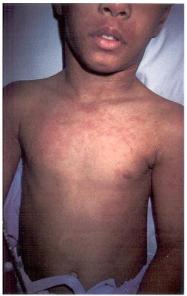
Figure 12–7 A 3-year-old boy with systemic JRA presenting with spiking fever and an exanthematous rash, eosinophilia, hepatomegaly, and adenopathy.
Signs and Symptoms
<< Back
-- Swinging/spiking fever
-- Rash − maculo−papular, especially on the torso
-- Lymphadenopathy
-- Hepato−splenomegaly
-- Arthralgia
-- Arthritis, multiple joints
-- Serositis, i.e. pericarditis and pleuritis
-POLYARTICULAR ONSET ARTHRITIS
-Signs and Symptoms
-- Affects ≥ 5 joints in the first 6 months
-- Involves large and small joints
-- Rheumatoid factor either positive or negative
-- Aggressive form of diseases with chronic course persisting into adulthood
-PAUCI − ARTICULAR ONSET ARTHRITIS

-
Figure 12–8 Pauciarticular JRA.
-Signs and Symptoms
-- Involves the large joints (wrists, knees, ankles or elbows)
-- Often asymmetrical distribution
-- ≤ 4 joints are involved
-- Associated with an increased risk of iridocyclitis/uveitis
-Complications
-- Leg length discrepancy
-- Scoliosis
-- Contractures
-- Iridocyclitis/uveitis
-Investigations
-- FBC, differential, ESR
-- Rheumatoid factor
-- X−ray of affected joints
-- Anti Nuclear Antibodies (ANA)
-Management
-Non-pharmaceutical management
-• Occupational and physiotherapy are essential
-• Education of the patient and their families
-Pharmaceutical management
-• First Choice: Brufen 5-10 mg/kg/dose x 3/day
-• Alternative: Prednisone PO 2 mg/kg as a single daily dose for 1– 2 weeks, continue with 0.3–0.5 mg/kg/day as single dose for 3 months
-If Arthritis not controlled
-• Give Methotrexate PO, 0.3 mg/kg/week as a single dose on an empty stomach, increase at monthly intervals up to 1 mg/kg/week until there is satisfactory response, maximum dose is 25 mg/week + folic acid 5mg daily for methotrexate treatment.
-Recommendation

-- Refer patient for rheumatology specialist consultation and adequate management (methotrexate treatment).
Dr: Essam Abdullah 01123232188
-
-
-7.1. Epilepsy
-Definition: Epilepsy is a condition characterized by recurrent seizures
-associated with abnormal paroxysmal neuronal discharges. When seizures are recurrent, persistent or associated with a syndrome, then the child may be diagnosed with epilepsy.
-Causes
-- Idiopathic (70-80%)
-- Secondary causes:
-• Cerebral dysgenesis or malformation
-• Cerebral vascular occlusion
-• Cerebral damage like Hypoxic Ischemic Encephalopathy
-(HIE), intraventicular hemorrhage or ischemia, head injury, infections
-• Cerebral tumors
-• Neuro-degenerative disorders
-Signs and Symptoms
-
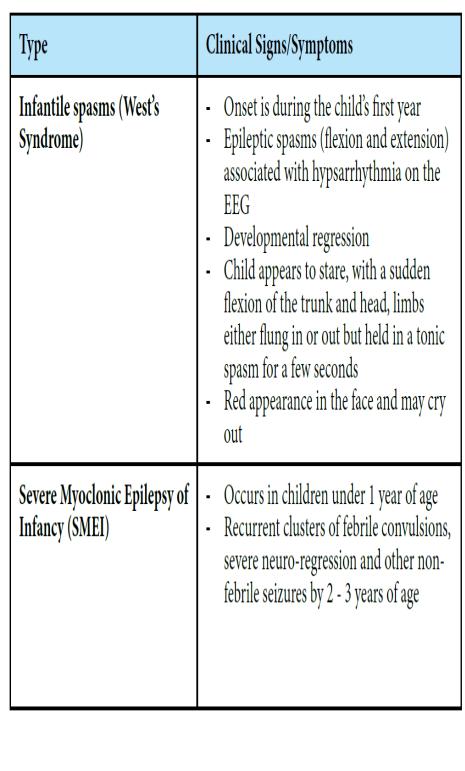
-
-
-
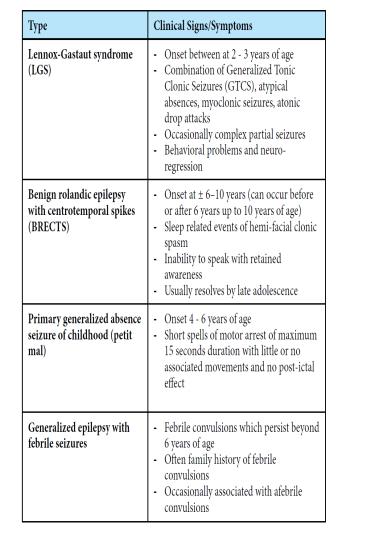
-

-
-Management
-Non Pharmaceutical
-• Acute management
-→ Manage Airway-Breathing-Circulation-disability and
-continue to monitor throughout seizures
-→ Place patient on side at 20 – 30° head up to prevent
-aspiration
-→ Monitor heart rate, respiratory rate, blood pressure,
-oxygen saturation (SaO2), neurological status, fluid balance
-→ Monitor laboratory values including blood glucose,
-electrolytes, blood gases, toxicology screen and if indicated anticonvulsant blood levels
-→ Control fever with tepid sponging
-→ Administer oxygen to maintain SaO2 of ≥ 95%
-→ If unable to protect airway or poor ventilation,
-consider use of an oral airway, bag-mask ventilation and/or intubation
-→ Admit to pediatric ward or to Intensive Care Unit if indicated
-• Long-term management
-→ Minimize the impact of the epilepsy by obtaining
-complete seizure control to maximize child’s full potential
-→ Educate the patient and parent or caregiver about epilepsy and associated complications (i.e. learning
-difficulties)
